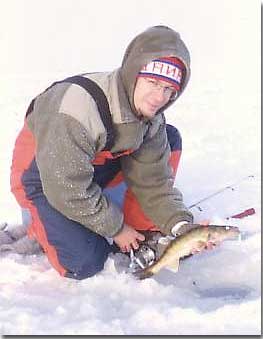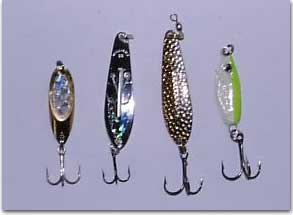Shallow Water ‘eyes Beneath the Ice
Shallow Water ‘eyes Beneath the Ice
By Justin Hoffman
As the year slowly slips away and Christmas presents are still fresh on the mind, the hard water has an uncanny way of beckoning anglers to drill through its outer layer. Ice fishing season is finally upon us and there is no better time to reap the rewards and scrape up some shallow water walleye; especially when the fishing can be fast, fun, and oftentimes, quite easy! Locations  While the term “shallow water” can be quite vague in its meaning, I usually class water less than 12 feet as being shallow. Lakes that are grouped in this class are typically weedy, and although they may have deeper water in them, for the most part, a large percentage of the total area is below the magic number. While the term “shallow water” can be quite vague in its meaning, I usually class water less than 12 feet as being shallow. Lakes that are grouped in this class are typically weedy, and although they may have deeper water in them, for the most part, a large percentage of the total area is below the magic number. First ice on shallow lakes is always the most productive time to hit the ice for a number of reasons. The first is that the water temperature is still quite warm, at least in winter terms, and this means the fish are most active and still readily searching out food. Another reason is the presence of healthy green weeds that offer ambush points, schools of baitfish and, of course, the oxygen needed by all life below the surface. Walleye in shallow water have typical patterns and locations that are quite common, and similar, in most bodies of water across North America. Early evening right through to mid-morning will find most of the walleye in the system in shallow and feeding aggressively. Throughout the day, the walleye will retreat back to “deeper” water and will remain quite in-active until the feeding window opens back up again in mid to late-afternoon. As the season progresses and water temperatures plummet, the activity in the walleye will decrease significantly and they will become very scattered and hard to find. As the shallow water weeds begin to turn brown and die, the walleye will shift from this very shallow water and will move out to deeper water. The mid-winter period will find fish on the first major drop-off out from the shallows. During this period the fishing can become quite tough, although searching out the greenest available weeds, and the drop-off, will help connect you with the fish. Considering this, most anglers in the know will hit shallow water lakes at their prime time, which is first ice, and will fish deep-water lakes during the inconsistent mid-winter period. Setting Up
Once out on the ice of a shallow water lake, the first step is to head out a couple of hundred yards and start drilling. What you are looking for is healthy green weeds, which is the most important step in finding the fish. This is the prime spot to set up, as the fish will either be buried in the thick of the weeds or patrolling along its outside edge. In either case it will see, or sense, your offering. Once you’ve drilled your primary hole, its now a matter of drilling secondary holes radiating out from the first, spaced approximately 15 to 30 feet apart. I normally start the day off with a half dozen of these secondary holes which will be used as a “milk run”, or fished in a race course pattern. Tools of the Trade
 There are literally hundreds of lures that can be used for walleye through the ice, but there are certain ones that seem to excel more in shallow water lakes. I usually depend on spoons that are a little bit lighter than most since the water being fished doesn’t have much depth, and also for the action and flutter they impart on shorter lines. Stick with spoons in the 1/8 to ½ oz., with the ¼ oz. weight getting the nod for most applications. Rocker Minnows, Walleye Hawger, Fire-Eye Minnows and Cleo’s have all produced for me in the past, but experimentation is definitely the key. Don’t be afraid to switch up often, varying the weight, size and colour.
There are literally hundreds of lures that can be used for walleye through the ice, but there are certain ones that seem to excel more in shallow water lakes. I usually depend on spoons that are a little bit lighter than most since the water being fished doesn’t have much depth, and also for the action and flutter they impart on shorter lines. Stick with spoons in the 1/8 to ½ oz., with the ¼ oz. weight getting the nod for most applications. Rocker Minnows, Walleye Hawger, Fire-Eye Minnows and Cleo’s have all produced for me in the past, but experimentation is definitely the key. Don’t be afraid to switch up often, varying the weight, size and colour. Tips and Techniques I see many people out on shallow water lakes roar up to a spot in a loud snowmobile or make a racket out on the ice while fishing, and usually just shake my head with amazement. Sound travels strongly through the ice, and since the water is so shallow, the chances of spooking the walleye is even greater. Once out on the ice, walk slowly and quietly, and keep noise to a minimum. A key is to drill a number of holes right at the start in order to let the area settle and put the fish more at ease. While out jigging, especially in water less than eight feet, be conscious of your jigging action. Small, short lifts will be your best bet, as any lift greater than a foot will be lifting the lure out of the strike zone. Also keep in mind that the snell length on tip- ups should be shortened and close to bottom in shallow water as the fish will not move up high to take a bait. If you are with a group of people then it is best to each set up at varying distances from shore, which will put each angler at a different depth. An example would be one person fishing in five feet of water, one at seven and the other at nine feet. This will give you a feel for how shallow the fish are, and if one angler starts getting into a school, then it’s simply a matter of setting up parallel from shore at this “magic depth.” Head out on the ice this year and take advantage of shallow water lakes, especially during the early part of the season. The water coloumn may be skinny, but the walleye will certainly be plump and abundant, and that’s what “just fishing” is all about!
|
